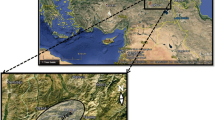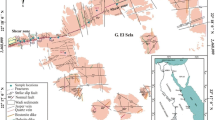Abstract
Spectral gamma-ray tools present the concentrations of the three radioactive elements responsible for the natural gamma radiation, which are thorium (Th), uranium (U), and potassium (K), separately. This separation can be interpreted geochemically and geologically to identify some formation characteristics, such as lithologies, clay types, fractures, unconformities, and hydrocarbon potentialities. In this study, the geochemical and geological contributions of the natural spectral gamma-ray spectrometry (NGS) log were interpreted to characterize the Rudeis Formation in well Amal-9, Amal field, the southern province of the Gulf of Suez, Egypt. The interpretation was supported by other logging tools, cuttings description, and Rock-Eval pyrolysis. The study revealed that reducing conditions were predominant during the deposition of most of the stratigraphic sequence of the Rudeis Formation. The sediments of the Rudeis Formation were identified into four lithofacies; each one has its own diagnostic spectral gamma radiation. The lithofacies are composed of sandstone (lowest radiation), limestone, shale, and marl (highest radiation). The U content can be considered as the main contributor to the radioactivity of the Rudeis Formation. Furthermore, there is a relationship between the U and the TOC contents, implying that U can be used as a proxy for organic richness shale and as an indicator for good source rock intervals in this formation. As indicated from several crossplots, the clay minerals are mainly represented by montmorillonite with a low percentage of kaolinite and illite. Several unconformities were detected, based on the dipmeter data and observing the abrupt change in both the Th/K ratio and U curves.











Similar content being viewed by others
References
Adams JAS, Weaver E (1958) Thorium to uranium ratios as indicators of sedimentary process: example of concept of geochemical facies. Am Assoc Pet Geol Bull 42:387–430
Alsharhan AS (2003) Petroleum geology and potential hydrocarbon plays in the Gulf of Suez rift basin, Egypt. AAPG Bull 87(1):143–180
Angelier J (1985) Extension and rifting: the Zeit region, Gulf of Suez. J Struct Geol 7:605–612
Bassiouni Z (1994) Theory, Measurement, and Interpretation of Well Logs, SPE Textbook Series 4
Bosworth W, McClay K (2001) Structural and stratigraphic evolution of the Gulf of Suez rift, Egypt: a synthesis. In: Ziegler PA, Cavazza W, Roberston AHF, Crasquin-Soleau S (eds.) Peri – Tethys Memoir 6: Peri – Tethyan Rift/ Wrench Basins and Passive Margins, pp 567–606
Bosworth W, Crerello P, Winn Jr RD, Steinmetz J (1998) Structure, sedimentation, and basin dynamics during rifting of the Gulf of Suez. In: Purser BH, Bosence DWJ (eds.) Sedimentation and tectonics of rift basins: Red Sea – Gulf of Aden, pp 78–96
Chowdhary LR, Taha S (1987) Geology and habitat of oil in Ras Budran field, Gulf of Suez, Egypt. AAPG Bull 71(10):1274–1293
Doveton JH (1991) Lithofacies and geochemical facies profiles from nuclear wireline logs: new subsurface templates for sedimentary modelling. In: Franseen EK, Watney WL, Kendall CJ, Ross W (eds.) Sedimentary modelling-computer simulations and methods for improved parameter definition. Kansas Geological Society Bulletin 233, pp 101–110
Durrance EM (1986) Radioactivity in geology: principles and applications. John Wiley
Egyptian General Petroleum Corporation, EGPC (1964) Oligocene and Miocene rock- stratigraphy of the Gulf of Suez region, report of the Stratigraphic Committee. Egyptian General Petroleum Corporation, p.142
Egyptian General Petroleum Corporation, EGPC (1996) Gulf of Suez oil fields (a comprehensive overview), Cairo
El Sharawy MS, Gaafar GR (2012) Application of well log analysis for source rock evaluation in the Duwi Formation, Southern Gulf of Suez, Egypt. J Appl Geophys 80:129–143
El Sharawy MS, Nabawy BS (2016a) Determination of electrofacies using wireline logs based on multivariate statistical analysis for the Kareem Formation, Gulf of Suez, Egypt. Environ Earth Sci 75(21):1394
El Sharawy MS, Nabawy BS (2016b) Geological and petrophysical characterization of the lower Senonian Matulla formation in southern and central gulf of Suez, Egypt. Arab J Sci Eng 41(1):281–300
Evans AL (1988) Neogene tectonic and stratigraphic events in the Gulf of Suez area, Egypt. Tectonophysics 153:235–247
Fertl WH, Frost E (1982) Experiences with natural gamma ray spectral logging in North America. BB B SPE 11145
Garfunkel Z, Bartov Y (1977) The tectonics of the Suez rift. Geol Surv Israel Bull 71:1–44
Hassan M, Hossin A (1975) Contribution a l'etude des comportements du thorium et du potassium dans les roches sedimentaires. C.R. Acad Sci (Paris) 280:533–535
Hassan M, Selo M, Combaz A (1975) Uranium distribution and geochemistry as criteria of diagenesis in carbonate rocks. Proceedings of the IX Congres International de Sedimentologie, Nice, France 7: 69–75
Hassan M, Hossin A, Combaz A (1976) Fundamentals of the differential gamma ray log interpretation technique. 17th SPWLA Annual Symposium 8: 1–7
Hesselbo SP (1996) Stratigraphy, Cenozoic of the Atlantic margin, offshore New Jersey. In: Mountain GS, Miller KG, Blum P, Poag CW, Twichell DC (Eds.) Proceedings of the ocean drilling program, scientific results 150, pp 411–422
Hughes GW, Abdine S, Girgis MH (1992) Miocene biofacies development and geological history of the Gulf of Suez, Egypt. Mar Pet Geol 9:2–28
Hurst A (1990) Natural gamma-ray spectrometry in hydrocarbon-bearing sandstones from the Norwegian Continental Shelf. In: Hurst A, Lovell MA, Morton AC (Eds.) Geological applications of wireline logs. Geol. Soc. Spec. Publ. London 48, pp 211–222
Jarvie DM, Claxton BL, Henk F, Breyer JT (2001) Oil and shale gas from the Barnett shale, Fort Worth Basin, Texas. AAPG Bull 85(Suppl. 13):A100
Leppard CW, Gawthorpe RL (2006) Sedimentology of rift climax deep water systems; Lower Rudeis Formation, Hammam Faraun Fault Block, Suez Rift, Egypt. Sediment Geol 191:67–87
McClay KR, Nichols GJ, Khalil SM, Darwish M, Bosworth W (1998) Extensional tectonics and sedimentation, Eastern Gulf of Suez, Egypt. In: Purser BH, Bosence DWJ (eds.) Sedimentation and tectonics of rift basins: Red Sea – Gulf of Aden, pp 224–238
Mitchum RM, Sangree JB, Vail PR, Wornardt WW (1993) Recognizing sequences and systems tracts from well logs, seismic data, and biostratigraphy: examples from the late Cenozoic. In: Weimer P, Posamentier HW (eds.) Siliciclastic sequence stratigraphy: Recent developments and applications. American Association of Petroleum Geologists, Memoir 58, pp 163–197
Montenat C, Ott d’Estevou P, Purser B (1986) Tectonic and sedimentary evolution of the Gulf of Suez and the northwestern Red Sea: a review. In: Montenat C (ed.) Geological studies of the Gulf of Suez, northwestern Red Sea coasts, tectonic and sedimentary evolution of Neogene rift: documents et Travaux Institut Geologique Albert de Lapparent 10, pp 7–18
Montenat C, Ott d’Estevou P, Purser BH, Burollet P, Jarrige JJ, Orszag-Sperber F, Philobbos E, Plaziat JC, Prat P, Richert JP, Roussel N, Thiriet JP (1988) Tectonic and sedimentary evolution of the Gulf of Suez and the northwestern Red Sea. Tectonophysics 153:161–177
Myers KJ, Jenkyns KF (1992) Determining total organic carbon content from wel logs: an intercomparison of GST data and a new density log method. In: Hurst A,Griffiths CM, Worthington PF (Eds.) Geological applications of wire linelogs II: Geol. Soc. London, Spec. Publ. 65, pp 369–376
Myers KJ, Wignall PB (1987) Understanding Jurassic organic- rich mudrocks—new concepts using gamma-ray spectrometry and palaeoecology: examples from the Kimmeridge Clay of Dorset and the Jet Rock of Yorkshire. In: Legget JK, Zuffa GG (eds.) Marine clastic sedimentology: London, Graham and Trotman, pp 172–189
Neal J, Risch D, Vail P (1993) Sequence stratigraphy—a global theory for local success. Oilfield Rev 5(1):51–62
Nielsen BL, Løvborg L, Sørensen P, Mose E (1987) Gamma-ray analysis for U, Th and K on bulk cutting samples from deep wells in the Danish subbasin and the north German basin. Report Risø-M-2646, p 85
Nio SD, Darwish M, Tewfik N (1996) Genetic frequency analysis of synrift deposits of the Gulf of Suez—a new approach in high – resolution sequence stratigraphy. 13th EGPC Exploration and Production Conference 2: 201–213
Noyau A (1985) Geochemical study of oils from Amal 9 – correlations with the oils from Amal 7 & Amal 8. Internal report no. 30 T 008 409 RL 3638 TP/de/ lab
Passey QR, Moretti FU, Stroud JD (1990) A practical modal for organic richness fromporosity and resistivity logs. AAPG Bull 74:1777–1794
Patton TL, Moustafa AR, Nelson RA, Abdine AS (1994) Tectonic evolution and structural setting of the Suez rift. In: Landon SM (ed.) Interior rift basins. The American Association of Petroleum Geologists Memoir 59, pp 9–55
Plaziat JC, Montenat C, Barrier P, Jania MC, Orszag-Sperber F, Philobbos E (1998) Stratigraphy of the Egyptian synrift deposits: correlations between axial and peripheral sequences of the northwestern Red Sea and Gulf of Suez and their relations with tectonics eustacy. In: Purser BH, Bosence DWJ (eds.) Sedimentation and Tectonics of Rift Basins: Red Sea – Gulf of Aden, pp 211–222
Ramzy M, Steer B, Abu Shadi F, Schlorholtz M, Mika J, Dolson J, zinger M (1996) Gulf of Suez rift basin sequence models—part B, Miocene sequence stratigraphy and exploration significance in the central and southern Gulf of Suez. Proceedings of the13th Egyptian General Petroleum Corporation Exploration and Production Conference 2: 242–254
Richardson M, Arthur MA (1988) The Gulf of Suez-northern Red Sea Neogene rift: a quantitative basin analysis. Mar Pet Geol 5:247–270
Rider M (1996) The geological interpretation of well logs. Gulf publishing company Houston, London, Paris, Zurich, Tokyo
Robertson Research International (RRI) (1986) The Gulf of Suez area, Egypt: stratigraphy, petroleum geochemistry, petroleum geology, six volumes Robertson Group, Leandudno
Schlumberger (1982) Natural gamma-ray spectrometry: essentials of N. G. S. interpretation Schlumberger, Texas
Schlumberger (1989) Log interpretation principles/ applications. In: Schlumberger Wireline & testing. Sugar, Texas
Schlumberger (1997) Log interpretation charts. Schlumberger Wireline & testing, Houston, Texas
Schmoker JW (1979) Determination of organic content of Appalachian Devonian shales from formation-density logs. AAPG Bull 63:1504–1509
Schmoker JW, Hester TC (1983) Organic carbon in Bakken Formation, United States portion of Williston Basin. AAPG Bull 67:2165–2174
Serra O (1984) Fundamentals of well-log interpretation: 1. the acquisition of logging data. Elsevier Science Publishers BV
Serra O (2007) Well logging and reservoir evaluation. Editions Technip - PARIS – France
Sharp Jr JM, Galloway WE, Land LS, McBride EF (1988) Diagenetic processes in northwestern Gulf of Mexico sediments. In: Chilingarian GV, Wolf KH (eds): Diagenesis, II: Development in Sedimentology 43, pp 43–113
da Silva T, Coutinho M (2011) Integrated petrophysical evaluation applied to the characterization of shaly-sand reservoirs in the Santonian Gas Field, Santos Basin, Brasil. Extended abstract, AAPG International Convention and Exhibition, Milan, Italy, October 23–26
Smale JL, Thunell RC, Schamel S (1988) Sedimentological evidence for early Miocene fault reactivation in the Gulf of Suez. Geology 16:113–116
Steckler MS, Berthelot F, Lyberis N, Le Pichon X (1988) Subsidence in the Gulf of Suez: implications for rifting and plate kinematics. Tectonophysics 153:249–270
Tissot BP, Welte DH (1984) Petroleum formation and occurrence. Springer-Verlag, New York
Acknowledgements
The authors are grateful to the Egyptian General Petroleum Corporation (EGPC) and the Gulf of Suez Petroleum Company (GUPCO) for releasing the data. Special thanks are given to the editor, associate editor, and reviewers for their trenchant insights, which helped to improve both the content and the style of this manuscript. Special thanks are given to Prof. Ahmed Abu El-Ata, Professor of Geophysics, Ain Shams University, for valuable comments and reviewing the manuscript.
Author information
Authors and Affiliations
Corresponding author
Rights and permissions
About this article
Cite this article
El Sharawy, M.S., Nabawy, B.S. The role of gamma-ray logs in deciphering geochemical and geological aspects of the Rudeis Formation, Gulf of Suez, Egypt. Arab J Geosci 11, 242 (2018). https://doi.org/10.1007/s12517-018-3560-0
Received:
Accepted:
Published:
DOI: https://doi.org/10.1007/s12517-018-3560-0




